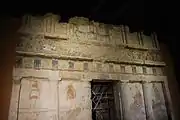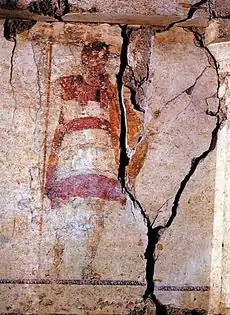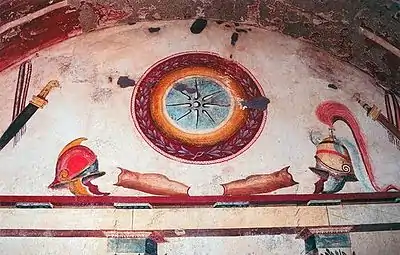Mieza (Macedonia)
Mieza (Ancient Greek: Μίεζα), "shrine of the Nymphs", was a town in ancient Macedonia, where Aristotle taught the boy Alexander the Great between 343 and 340 BCE.[1] Ptolemy classifies Mieza among the cities of Emathia.[2] Stephanus of Byzantium, on the other hand, deriving his information apparently from Theagenes, alludes to it as "τόπος Στρυμόνος", and adds that it was sometimes called Strymonium. The site where Mieza once stood is the modern Lefkadia, near the modern town Náousa, Imathia, Central Macedonia, Greece, and has been the subject of archeological excavations since 1954.[3]

Mieza was named for Mieza, in ancient Macedonian mythology, the daughter of Beres and sister of Olganos and Beroia. It was the home of Alexander's companion Peucestas. Aristotle was hired by Alexander's father, Philip II of Macedon, to teach his son, and was given the Temple of the Nymphs as a classroom. In return, Philip re-built and freed the citizens of Stagira, Aristotle's hometown, which he had razed in a previous conquest across Greece and Macedon.[4]
Students educated at Mieza include Hephaestion, Ptolemy I Soter, Cassander, and Cleitus the Black.
Gallery
_(7263455202).jpg.webp) Modern statue of Aristotle near the School
Modern statue of Aristotle near the School%252C_Lefkadia%252C_Ancient_Mieza_(7272131400).jpg.webp) Kinch's Tomb
Kinch's Tomb.jpg.webp) Facade of the "Tomb of the Palmettes" (3rd BC)
Facade of the "Tomb of the Palmettes" (3rd BC) Facade of the "Tomb of Judgment" (4th/3rd C BC)
Facade of the "Tomb of Judgment" (4th/3rd C BC) Fresco from the Tomb of Judgment showing religious imagery of the afterlife (Hermes Psychopompos)
Fresco from the Tomb of Judgment showing religious imagery of the afterlife (Hermes Psychopompos) Another fresco from the Tomb of Judgment showing imagery of the afterlife
Another fresco from the Tomb of Judgment showing imagery of the afterlife Painting from the Tomb of Lyson and Kallikles (3rd C BC)
Painting from the Tomb of Lyson and Kallikles (3rd C BC)
References
- pothos.org. Aristotle (384-322 BC) Archived 2012-07-28 at the Wayback Machine
- Ptolemy. The Geography. 3.13.39.
- Orkin, Lisa (18 July 1999). "Greece – Ruins Renewed: Seeking New Life For Past Glories". The Seattle Times (via Associated Press).
- DeGategno, Paul J. and Stubblefield, R. Jay (2006). Critical Companion to Jonathan Swift, p. 32. Infobase Publishing. ISBN 1438108516
![]() This article incorporates text from a publication now in the public domain: Smith, William, ed. (1854–1857). "Mieza". Dictionary of Greek and Roman Geography. London: John Murray.
This article incorporates text from a publication now in the public domain: Smith, William, ed. (1854–1857). "Mieza". Dictionary of Greek and Roman Geography. London: John Murray.
External links
| Wikimedia Commons has media related to Mieza, Macedonia. |
- Images of the ruins of Mieza and brief description of the site (School of Aristotle and Cultural Center, Naousa)
